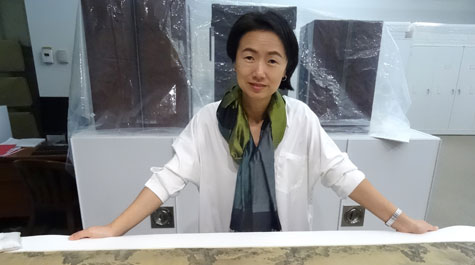Professor connects ancient Chinese landscapes, art objects to now
Past informs present, even an antique art object or the landscape of a long-defunct academy, Xin Conan-Wu would like her students to remember.
This idea pervades her research and even more so her teaching.
Conan-Wu, associate professor of art and art history at William & Mary, has been moving back and forth between the two a lot. She spent the 2016-17 academic year doing research on a Kluge Fellowship at the John W. Kluge Center of the Library of Congress, the spring of this year on the same project and will continue the research next spring on the last leg of her research leave.
This fall she is teaching a new COLL 200 survey course on the history of Asian art that covers South, Southeast and East Asia, primarily from India to China, Korea and Japan, as well as a higher-level course on modern and contemporary Chinese art from the late 19th century to the present.
Conan-Wu values students’ personal engagement with artworks and wants them to discover through personal reflection how art can be relevant for them, she said. This goes beyond reproducing her judgment, either aesthetic or otherwise.
One assignment she designed asks students to write about an aspect of the course material probing at the most unfamiliar. She asked them, for example, to write a letter to a fictional friend explaining why Neolithic Chinese jade or pottery is a work of art.
This projective technique enables students to distance themselves from applying contemporary notions to ancient people’s practices and judgments and to creatively explore the objects’ deeper meanings, artists’ motivations and users’ responses from an art-historical view, she said.
“We try to make students understand that there’s a historical perspective about the artwork and to see the creation of art as part of human development, as part of our history and our culture,” Conan-Wu said.
Her current research is a book project examining the role of landscape in the pedagogy of Confucian academies in 12th-century China. It describes the ancient philosophical schools where Neo-Confucianism formed, just before it became the source of interpretation demanded at the imperial exams for the recruitment of scholar officials, and later the official ideology of the empire until the very beginning of the 20th century.
It is well known among scholars that this pedagogy demanded a thorough study of classical texts. But it is not at all recognized, even in China, that a fundamental Neo-Confucian principle recommended investigating all things under heaven and Earth, even a blade of grass, to understand how it contributed to the harmony of the cosmos, Conan-Wu said. This was a slow cumulative task that was a prerequisite for reaching complete wisdom, and thus to be able to pass intuitive judgment on any event or topic of government without ever being wrong.
Research has included field studies in her native China and archival work at the Library of Congress and around the world. Conan-Wu plans to have a first draft of her manuscript complete next summer.
The idea of landscape includes gardens, wilderness, planting and architecture, and all the cultural significations that were attached to space, she said. This landscape was a symbol of the timeless presence of the community of Confucian sages, not a symbolic representation. Thus its contemplation led to immersion and Confucian reflexivity that made it part of the learning process.
“Being there was a way of engaging with the longer history of a larger culture,” Conan-Wu said. “Your body was being there. So it was a different way of learning as opposed to just reading books in the library.
“So that’s how the landscape part was tied together with pedagogy and memory, how students were making use of that cultural construction of landscape, which is at complete variance with ours, separating time and space, aesthetics and ethics. The time spent in the landscape could erase centuries and lead to dialogue with the ancients and the sages, as the classical arts did for European nobilities in the age of humanism.”
This may seem extremely specialized and out-of-touch with the present world. Yet, landscape, she said, allows her to branch out from there and connect the historical to the contemporary. Even for a superficial observer, it is manifest that landscape architecture in the U.S., Europe and China has been engaged in ethical debates about the relationships between humans and nature, the ancient Chinese said between humans and the cosmos, Conan-Wu said. They are much closer than it would seem at first sight.
“For students, it’s a very important experience to be exposed to a longer history and a bigger world,” she said. “Then also in my own experience, I always think comparative studies are very useful. It’s never enough to put things side by side, but we can learn much when we try to understand both differences and similarities together.”
 Skip to main content
Skip to main content

